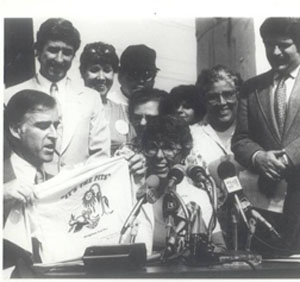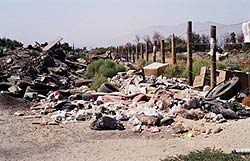Pollution by Design: Reducing Pollution Through Organizing
By Penny Newman
Thirty five years ago, I joined a rag tag group of moms who gathered together to decide how we were going to stop the exposures from the Stringfellow Acid Pits, a permitted Class 1 toxic dump site that accepted chemical wastes from throughout California. This was in response to an incident where the State of California, during a heavy rain period, released over one million gallons of liquid toxic waste into our community in order to relieve pressure on a the dam that was holding back 34 million gallons of hazardous waste. They did this without informing us, flooding our streets, and inundating our homes and school. Our children splashed in the puddles, made beards and became snow men in the frothy mounds of gray toxic foam.
 When we realized what had happened, we decided we’d had enough. Concerned Neighbors in Action (CNA) formed to stop it. By 1980 we began to hear rumors of places like Love Canal and Times Beach, where communities were experiencing similar problems. Putting our heads and hearts together we launched into a decade long battle to make the system respond to the health crisis that we, and other communities, were facing. Our efforts changed laws, developed legal precedent and created new institutions.
When we realized what had happened, we decided we’d had enough. Concerned Neighbors in Action (CNA) formed to stop it. By 1980 we began to hear rumors of places like Love Canal and Times Beach, where communities were experiencing similar problems. Putting our heads and hearts together we launched into a decade long battle to make the system respond to the health crisis that we, and other communities, were facing. Our efforts changed laws, developed legal precedent and created new institutions.
In 1993, after stopping the exposures and winning a personal injury lawsuit with a $114 million settlement, CNA became the Center for Community Action and Environmental Justice (CCAEJ) to broaden our work and bring focus to the underlying factors of polluted communities. We learned that these situations don’t just appear by accident. They are the result of a system that seeks the lowest costs, which can lead to high polluting industries locating their operations in poorer communities and communities of color. This is why CCAEJ has developed a mission of “bringing people together to improve our social and natural environment,” as recognition that the social environment—economic, political, education— determine the fate of our community’s environment and our living conditions.
If we do not have the power to influence decisions in those systems, they will be used to advance other interests. It is not by accident that our small rural community ended up with the Stringfellow Acid Pits – it was a decision made by powerful interests taking advantage of the system. The goal was to find cheap places to dump their poisonous wastes in a place that is out of sight—commonly called “remote disposal.” While we knew this by instinct, our feelings were confirmed when we uncovered a report commissioned by the State of California and written by a consulting firm. It profiled the communities that would be the easiest to site polluting facilities. In the summary they write, “all socioeconomic groupings tend to resent the nearby siting of major facilities, but the middle and upper socioeconomic strata possess better resources to effectuate their opposition.”
 In other words, pick the most vulnerable communities. Understanding that poor communities and communities of color are targeted for pollution is an important factor in how to attack the problems. That’s why CCAEJ works specifically in Inland Valley communities like Riverside and San Bernardino in Southern California; which face some of the highest levels of air pollution in the country today. Building power for these forgotten communities through leadership development, trainings, and actions; forcing the public and politicians to see the issues so they can’t be ignored or hidden; and flexing our political power is the true pathway to environmental justice.
In other words, pick the most vulnerable communities. Understanding that poor communities and communities of color are targeted for pollution is an important factor in how to attack the problems. That’s why CCAEJ works specifically in Inland Valley communities like Riverside and San Bernardino in Southern California; which face some of the highest levels of air pollution in the country today. Building power for these forgotten communities through leadership development, trainings, and actions; forcing the public and politicians to see the issues so they can’t be ignored or hidden; and flexing our political power is the true pathway to environmental justice.
Penny Newman is executive director and founder of the Center for Community Action and Environmental Justice (CCAEJ), which serves Riverside and San Bernardino counties. She began her fight for environmental justice with the battle of the Stringfellow Acid Pits, California’s worst toxic waste site. This 25-year battle of a small town against the pollution from the Stringfellow site is recounted in her book, “Remembering Stringfellow.” Ms. Newman has received numerous awards during her 27 years as an environmental activist, including Jurupa’s “Citizen of the Year.” Newman has also appeared on numerous television shows such as the “Remembering Your Spirit” segment of the Oprah Winfrey show. She was the subject of an HBO documentary, “Toxic Time Bomb.”








 Have you heard about President Obama’s
Have you heard about President Obama’s  The Torres Martinez Reservation in southern California has historically been a magnet for illegal dumping. With rapid development in the area, large migrant worker population, and commercial agricultural operations, the open land of the reservation was seen as an easy place to dump illegally. The problem became so bad that operators on the reservation started collecting money to accept waste on their property, creating environmental and human health hazards from ill-managed and exposed dumps, which often caught on fire. The business school concept of “maximize profit and minimize cost” needed to change to “maximize human health and minimize harm to the environment”.
The Torres Martinez Reservation in southern California has historically been a magnet for illegal dumping. With rapid development in the area, large migrant worker population, and commercial agricultural operations, the open land of the reservation was seen as an easy place to dump illegally. The problem became so bad that operators on the reservation started collecting money to accept waste on their property, creating environmental and human health hazards from ill-managed and exposed dumps, which often caught on fire. The business school concept of “maximize profit and minimize cost” needed to change to “maximize human health and minimize harm to the environment”.